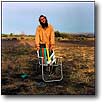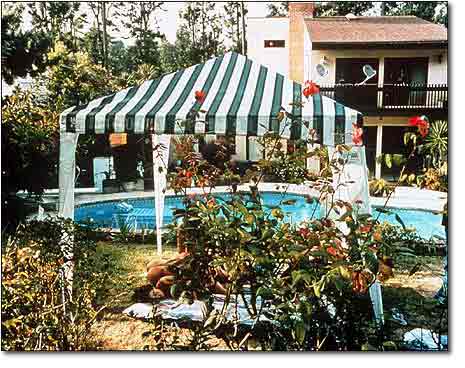Vancouver Art Gallery,
Jun 05, 2004 - Aug 29, 2004
Vancouver, BC, Canada
Baja to Vancouver
by Cassandra Coblentz
Marcos Ramirez ERRE’s Crossroads (Tijuana/San Diego) consists of signposts pointing away from the Mexico-U.S. border, towards 10 international cities. Imitating official signpost for tourist attractions, the viewer is positioned at a literal and figurative crossroads, forced to orient themselves spatially and conceptually within the physical context of an exhibition that grounds itself in its local site yet also keeps a subtle awareness of the region’s relationship to the rest of the world. Ramirez pairs the names of cities and their distance from the Mexican-U.S. Border with quotes by influential artist; such as Paris 9,160 km/The only works of art produced by America are its plumbing fixtures and its bridges- Marcel Duchamp, or Vancouver 1,891 km/ Transgression is the beginning of authentic existence- Jeff Wall. Reading the signposts, the arbitrary relationships between the cities and the quotes raises the question of whether or not various modes of artistic production can be seen to have relevant relationships to a specific local culture and context without really acknowledging a larger global politics. Herein lies the tension that makes Baja to Vancouver an exhibition well worth grappling with. Rather than emphasizing national borders, Baja to Vancouver takes cities in geographic proximity to one another, on the west coast of North America as the organizing principle of the exhibition. A collaborative effort between curators from Vancouver, Seattle, San Francisco and San Diego, the exhibition aims to reinforce the idea of the west coast as a cohesive region that stands in strong opposition to New York or Europe as an important center of contemporary artistic production. In Baja to Vancouver the move to incorporate two cities outside of the US borders, Tijuana to the south and Vancouver to the north cannot be viewed as an apolitical gesture. The claim that this region is one that transcends national borders is one that attempts to reorient our conceptual map of this region and question traditional paradigms that have separated Mexican and Canadian culture from the U.S. Baja to Vancouver’s disregard for the national associations and can be seen as an effort to demonstrate that this region is one that has triumphed over outmoded concepts of borders and nationalism. This idea of the North American west coast has been the subject of an exhibition before. In 2000 the Museum of Contemporary Art, Los Angeles produced and exhibition entitled Flight Patterns, which expanded it’s curatorial scope to include the entire Pacific Rim, thus establishing a difference between the notion of regionalism in Baja to Vancouver and that one takes on the context of the Pacific Rim as an increasing economic and industrial force in the world. Flight Patterns treated regionalism not a topic to be avoided but rather an opportunity to expand an understanding of our perspective of that region, to broaden the spectrum of our global political reference. Baja to Vancouver explicitly denies trying to make any generalized statement about the region, and therefore takes an evasive approach to global politics. The terms Cultural Terrain and Social Landscape are both used in gallery wall text and the exhibition catalogue. These kinds of qualifying phrases suggest that these west coast cites are not only in physical proximity to one another but that the social and cultural issues specific to each city also relate to the overall region. However for a show organized around local, only a few works deal specifically with local social, political or cultural issues. Yvonne Venega’s photographs of young affluent women in intimate personal settings or attending bridal showers and parties, revel the complexities of the evolving culture of contemporary Tijuana, and the conflicts and poignancy of the interactions among women as they pla
|









